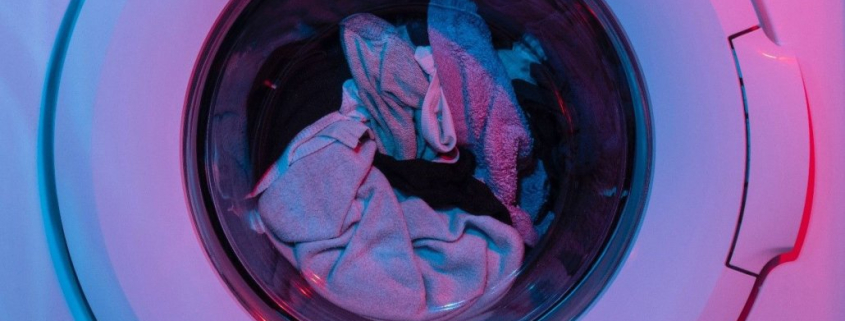
Reduce Microplastics Pollution from Your Laundry
Microplastics, defined as plastic particles less than 5 mm in length, are everywhere. Although they are tiny, microplastics are a growing concern as an environmental pollutant, especially in marine ecosystems.

Microplastics can contain harmful chemicals that may leach into the environment and be adsorbed into body tissues. It is not just a problem for a few filter feeding critters, alarmingly, microplastics are making their way through the entire marine food web all the way to our dinner plates!
To our shoreline neighbours like forage fish, killer whales and sea birds, microplastics disrupt feeding and growth patterns by physically filling the stomachs of these animals and reducing the amount of nutrients they absorb. Added chemicals that alter the flexibility, durability or colour of plastics can also impact these animals by building up as toxins in their tissues, a process known as bioaccumulation.
Did you know that a large portion of microplastic pollution comes from laundering our clothes – over 35%, in fact! Synthetic fabrics such as polyester and nylon shed tiny plastic fibers every time they are washed. A single load of laundry can release roughly 700,000 bits of microplastic! These particles are so small that they often escape waste water treatment facilities and end up in our waterways and the ocean.
It is critical that we do our part to prevent microplastics from entering the marine environment, because once they are there, they are impossible to clean up.
Luckily, we can reduce microplastic pollution by making some conscious changes to how we do laundry.

What can you do?
- Opt for natural fabrics that biodegrade – whether you are buying new or second-hand clothing items, select natural materials such as cotton, linen, wool, silk and rayon. These natural, plant or animal-derived materials will still contribute microfibers to your wash water, but those fibres will biodegrade in the environment. If you have only natural fabrics in your load you can even compost your dryer lint!
- Avoid synthetic materials – such as nylon, polyester, acrylic and spandex/lycra. These are materials that are commonly used for fitness clothing like leggings, shorts and lightweight jackets. For shedding, the worst offender is fuzzy polyester fleece.
- Wash sparingly – consider if you can wear your clothes another time before washing. Try to spot clean a spill rather than wash the entire garment. Limiting the frequency of washing will reduce the overall amount of shed fibers (and help your clothes last longer!).

- Invest in a microfiber filter – such as the one above by PlanetCare or the one on the left by Filtrol for your washing machine to prevent plastics from entering your waste water. These clever little devices make a big impact in helping reduce your household input of microplastics into our coastal waters.
- Use cold water – for your washes. The warm water settings will break down fabrics faster, compared to cold water washes.
- Avoid the gentle cycle – and other settings that increase the washing time of laundry loads. Fabrics will break down more the longer they are being tossed around in your washing machine.
- Choose a front loader – when selecting a washer, , which are gentler and do not cause as much shedding as top loaders.
- Hang your laundry to dry – when you can to avoid the heat and friction of the dyer, which can also break down fabrics prematurely (also a great way to save electricity).
- Use mesh laundry bags – for your synthetic clothing, such as the Guppyfriend bag, to capture microplastics. Remember, when you clean the bag out the fibres should be thrown away with your garbage and not washed down the drain.

- Try the Cora Ball – as another option to add to your laundry machine. It is an engineered ball that helps reduce the amount of fibres that break off of our clothes as they tumble, and collects any fibres that do into fuzz that clings to the ball.
- Choose your detergent carefully! It’s tough to make a good choice:
Powdered detergents generate more friction during a wash cycle, and may cause more fibers to break off of fabrics; detergent pods and detergent sheets contain polyvinyl alcohol a type of dissolvable plastic (liquid polymer) that is not easily removed by wastewater treatment plants; liquid detergents are typically packaged in plastic jugs that, if not disposed of properly, can also contribute to the plastic problem; and, some detergents may even have tiny added microplastic beads!

Read more about how to choose a microplastic free detergent in this article from the Ethical Consumer and see how different detergents compare for environmental safety with the Environmental Working Group’s Healthy Cleaning Guide.
The best option is to purchase liquid detergent from zero waste stores that sell soaps and detergents in bulk. You can then bring your own container and refill it again and again! Next best is to source environmentally safe liquid detergent in jugs that are made up of recycled content and/or are easily recyclable (check out our Tool Kit on Decoding Eco Labels).
Learn more:
CBC Article: Your laundry and plastic pollution — which fabrics shed the most microplastics
Oceanwise: Microplastics and home laundry
Follow blue land on Instagram for incredible educational content about the impacts of conventional cleaning products, and what we can choose instead.
Photo credits: Washing machine, Engin Akyurt onPexels; Waves, Ivan Bandura on Unsplash; PlanetCare; Filtrol; Cora Ball; Detergent refill, Sarah Chai on Pexels
